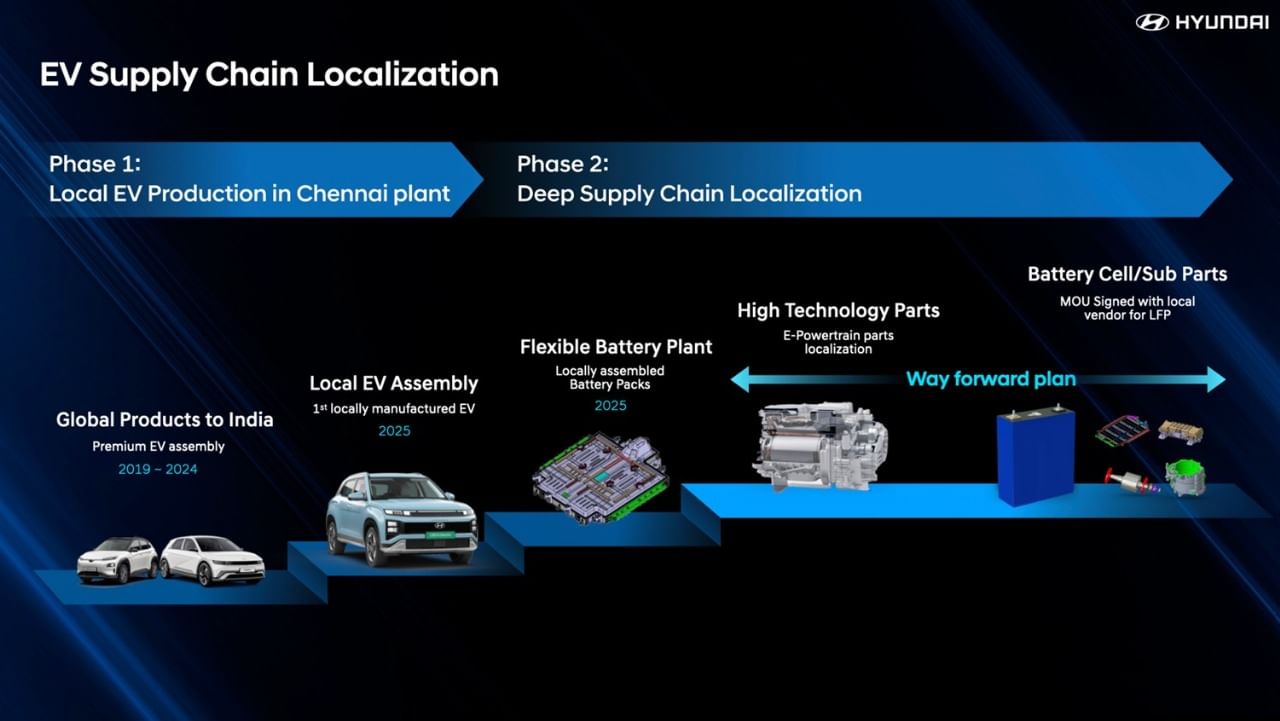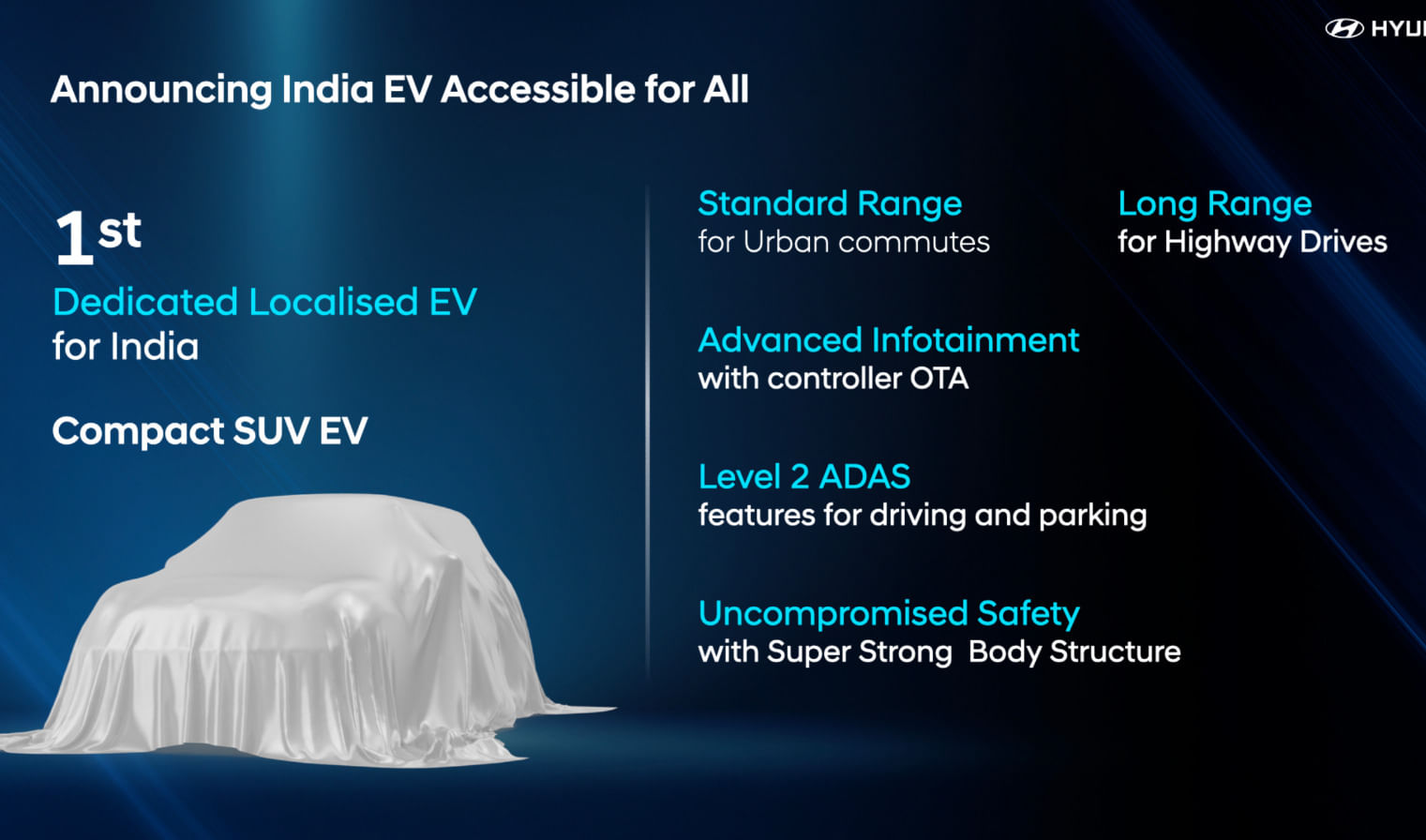Hyundai Motor India will launch its first fully locally designed, engineered, and manufactured electric SUV in India by 2027, marking a major strategic shift for the Korean carmaker as it deepens its localisation push and prepares for a rapid transition to electrified mobility in one of the world’s fastest-growing automotive markets.
“India will have its first locally manufactured dedicated electric SUV by 2027. Designed, engineered, and built in India for Indian customers,” said José Muñoz, President and CEO, Hyundai Motor Company, at the company’s Investor Day 2025. The model, he added, will form a cornerstone of Hyundai’s broader plan to make India a global hub for sustainable mobility solutions.

Hyundai’s EV roadmap for India is structured in two phases. Phase 1, already underway, focuses on local vehicle assembly at the company’s Chennai plant–the automaker launched Creta EV earlier this year. Alongside, it is establishing a flexible battery manufacturing plant, which will begin assembling battery packs locally this year.
Phase 2 will focus on deep localisation of the EV supply chain, including high-technology e-powertrain components and local sourcing of battery cells and sub-parts in collaboration with Indian suppliers.
“This deep-dive localisation strategy isn’t just good for business,” Muñoz said. “It is our commitment to building a sustainable, self-reliant automotive ecosystem in India.”
Hyundai is planning to launch 26 new vehicles in India by 2030, with more than 50% of its portfolio comprising eco-friendly vehicles, underlining its ambition to lead the country’s transition to sustainable mobility. The roadmap includes four launches over the next year, eight in FY2027 and FY2028, and 14 between FY2029 and FY2030.
Breaking this down, Hyundai will roll out seven all-new nameplates designed specifically for India, six full-model changes, six derivative models, and seven product enhancements over the next five years.
By the end of the decade, Hyundai’s Indian lineup will comprise 13 ICE models, five EVs, eight hybrids, and six CNG models, reflecting a balanced product mix aimed at addressing diverse customer needs while steering the market toward cleaner technologies.
Hyundai is also embedding localisation into its operational backbone. “With a 100% localisation ratio and expanding EV supply chains, our embedded functions in sales, design and supply chain management respond to local market demands with agility,” he added.
Hyundai’s manufacturing presence in India is also set to expand significantly. Its Chennai plant, which has been operational for over 25 years, remains central to its operations. Later this year, Hyundai will inaugurate its new facility in Pune, with an annual capacity of 250,000 units. This multi-model plant will showcase software-defined manufacturing, allowing the company to respond swiftly to market trends and technological shifts.
“Localization goes deeper,” Muñoz said. “We are localizing the entire EV supply chain, working with tier-1 to tier-3 suppliers. This creates jobs, builds capability and gives us a cost structure to compete and win.”
Hyundai continues to hold a strong position in India’s internal combustion engine (ICE) market, which still represents the bulk of industry profit pools. In FY25, the company held approximately 14% market share in the ICE car segment and 18% in the ICE SUV segment. It has also carved out a 6% share in the growing EV SUV space, laying the foundation for its future electric portfolio.
“Today, internal combustion engines on SUVs and cars represent the majority of India’s automotive profit pools,” Muñoz noted. “As we look towards 2030, not only will the overall profit pool grow, but the most dramatic growth will be in electrified vehicles.”
Hyundai projects that between 2025 and 2030, BEV SUVs will grow by 500%, hybrid SUVs by 600%, hybrid cars by 2,300%, and MPV EVs by 15,000%. Despite this exponential growth, ICE vehicles are expected to continue contributing nearly half of the industry’s profits.

